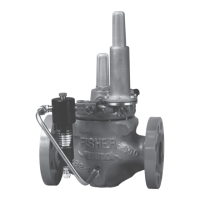For PRX Series pilots (Figure 26), loosen locknut
(key 2) and turn the adjusting screw into the spring case
to increase (or out of the spring case to decrease) the
downstream pressure. When the required downstream
pressure is maintained for several minutes, tighten the
locknut to lock the adjusting screw in position
and replace the pilot closing cap.
The Restrictor and Damper screws on the PRX Series
pilot control the regulator’s proportional band (droop)
and speed of response. Table 7 includes the appropriate
settings for low ow operation. For additional tuning
follow the steps outlined below:
1. Start with the restrictor screw 1 turn
counterclockwise from fully seated (turn restrictor
fully clockwise then 1 turn counterclockwise) and the
damper screw fully counterclockwise.
2. Turn damper screw clockwise until desired
performance is achieved. This reduces the ow path
of the damper. If the damper becomes fully seated
(no longer able to turn clockwise) and the desired
performance has not been achieved, return the
damper screw to the fully counterclockwise position.
PILOT TYPE
RECOMMENDED TYPE 112
RESTRICTOR SETTINGS FOR LOW
FLOW OPERATION
RECOMMENDED ORIFICE SIZE(S)
FOR LOW FLOW OPERATION
TYPE 112 RESTRICTOR SETTINGS
AND ORIFICE SIZES TO AVOID AT
LOW FLOW
161AY Series Pilots Restrictor Setting of “5” or greater
3/32 or 1/8 in. / 2.38 or 3.18 mm
(3/32 in. / 2.38 mm is standard)
Avoid restrictor setting of “2” or less if
continuous ows are expected to be
less than 5% of maximum capacity
Note: Higher Type 112 restrictor settings will increase proportional band. Adjustment of the Type 112 restrictor will also cause a shift in setpoint. Setpoint should be checked and adjusted
following restrictor setting adjustment.
Table 6. Type 161AY/161AYM Pilot Adjustment Recommendations
Table 7. Type PRX Pilot Adjustment Recommendations
PILOT TYPE
RECOMMENDED TYPE PRX RESTRICTOR AND DAMPER
SCREW SETTINGS FOR LOW FLOW OPERATION
TYPE PRX RESTRICTOR AND DAMPER SCREW
SETTINGS TO AVOID AT LOW FLOW
PRX/120 and PRX/120-AP Series
Restrictor Screw
- 1 turn out (counterclockwise) from fully seated for most
low ows
- 2-1/2 turns out (for ows less than
5% of maximum)
Damper Screw
- Fully out (counterclockwise) from seated for most
low ows
- One turn out (for ows less than 5% of maximum)
Restrictor Screw
- Fully seated (clockwise) or full out
(counterclockwise)
Damper Screw
- Full in (clockwise)
Note: Counterclockwise adjustment of the Type PRX restrictor screw will increase proportional band. Adjustment of the restrictor screw will also cause a shift in setpoint. Setpoint should
be checked and adjusted following restrictor screw adjustment.
Table 5. 161EB Series Pilot Adjustment Recommendations
PILOT TYPE
RECOMMENDED TYPE 112 RESTRICTOR
SETTINGS FOR LOW FLOW OPERATION
TYPE 112 RESTRICTOR SETTINGS TO AVOID
AT LOW FLOW
161EB Series Pilots Restrictor Setting of “5” or greater
Avoid restrictor setting of “2” or less if continuous
ows are expected to be less than 5%
of maximum capacity
Note: Higher Type 112 restrictor settings will increase proportional band. Adjustment of the Type 112 restrictor will also cause a shift in setpoint. Setpoint should be checked and adjusted
following restrictor setting adjustment.
!
WARNING
The damper screw should not be left in
the fully seated position, as it will lock
the regulator in last position which could
cause incorrect pressure regulation.
3. Turn the restrictor screw an additional turn
counterclockwise from fully seated. This increases
the ow path of the restrictor. If additional tuning
is required, repeat step 2. Follow this method until
desired performance is achieved.
Type 112 Restrictor Adjustment
The Type 112 restrictor controls the regulator’s
proportional band (droop) and speed of response. The
restrictor can be used to ne tune the regulator for
maximum performance by decreasing the restrictor
setting for tighter control (increased opening speed,
decreased closing speed); or increasing the restrictor
setting for maximum stability (decreased opening speed,
increased closing speed). A lower setting also provides
a narrower proportional band for better accuracy. The
“8” position has the largest ow, is most stable and
easiest for startup, however, using the “8” position
12
Type EZR

